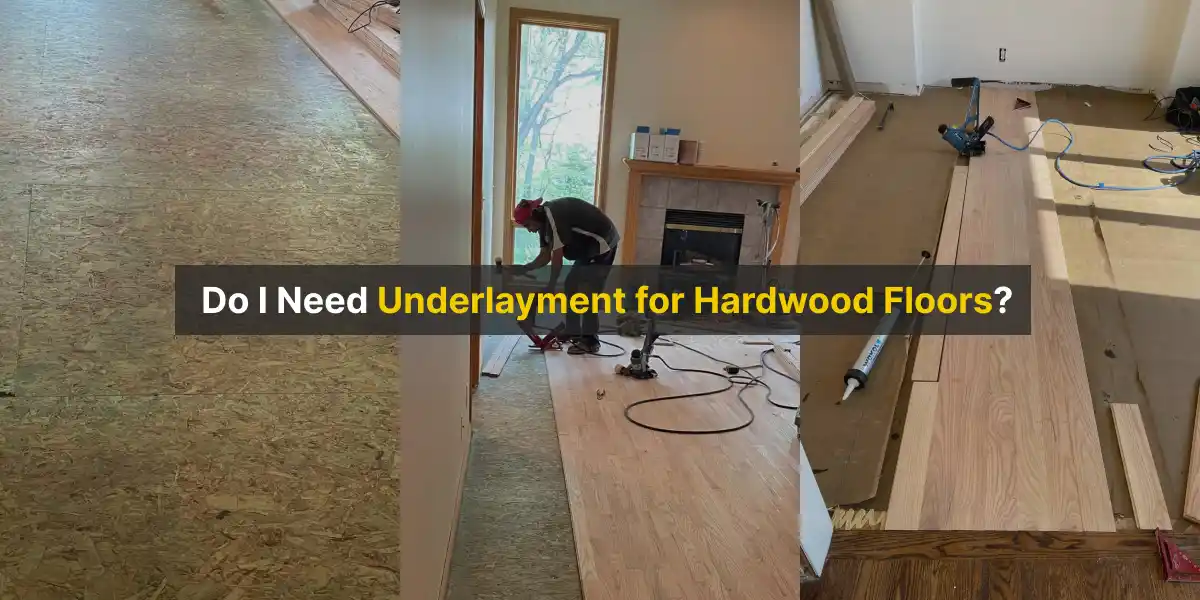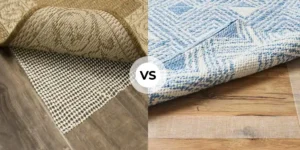The hardwood floors in your home add value, but they are pricey, so they need to be protected.
You may not know, but every homeowner prefers hardwood floors.
Because they want to give their home a natural feel.
Yet, it requires regular care and maintenance.
So, if you properly maintain hardwood floors, they will last for a long time.
But, before installation, one question arises: Do I need underlayment for hardwood flooring?
The simple answer is yes. You can use underlayment for hardwood floors.
Because it protects hardwood floors from water damage.
Using underlayment can provide you with other benefits as well.
Do I Need Underlayment for Hardwood Flooring?
The need for underlayment for hardwood flooring depends on various factors.
Such as the type of subfloor, the specific hardwood product, and your preferences.
Plus, it provides stability, sound dampening, cushioning, moisture resistance, and warmth, and hides imperfections.
Often, underlayment is not a strict need only if the subfloor is in good condition.
And there are no specific installation considerations.
But, there are situations where underlayment can be beneficial:
- Moisture Protection
- Sound Insulation
- Temperature and Comfort
Always check the specific recommendations of the hardwood flooring manufacturer.
As they may have guidelines about the use of underlayment.
How to Choose the Right Underlayment for Hardwood Flooring?
Choosing the right underlayment depends on the room’s needs and the hardwood flooring’s quality.
The type of underlayment material should also be considered.
- Check Manufacturer Recommendations: Start by checking the manufacturer’s recommendations for your specific hardwood flooring. Some manufacturers may have specific requirements or suggestions for compatible underlayment materials.
- Understand Subfloor Conditions: Different types of underlayment are suitable for different subfloor materials. Ensure the underlayment is compatible with your subfloor.
- Consider Moisture Levels: If you are installing hardwood over a concrete subfloor. Or in an area prone to moisture, choose an underlayment with a built-in moisture barrier.
- Sound Control Needs: If sound insulation between floors is a concern. Look for underlayment designed for sound control. These products help reduce impact noise. Making them suitable for multi-story buildings or areas where noise reduction is essential.
- Thickness and Density: Thicker underlayments with higher density often provide better support and sound absorption. But, ensure the height doesn’t interfere with door clearances.
- Installation Method: The installation method of your hardwood flooring can influence the choice of underlayment. For example, if you are nailing down solid hardwood. The underlayment requirements may differ from those for a floating or glue-down installation.
7 Reasons Why Underlayment is Essential for Hardwood Flooring
1. Moisture Barrier
The most common issue about a hardwood floor is water damage.
Moisture can weaken and damage wood by causing it to crack and crack, allowing mold to grow.
An underlayment is highly recommended to protect newly installed hardwood floors from moisture.
Moreover, the most effective underlayments include vapor or moisture barriers.
It will prevent moisture from penetrating inside and damaging your hardwood floor.
2. Sound Reduction
If hardwood is without an underlayment, it can be fairly loud.
You will usually hear a hollow clicking sound when walked upon.
Underlayment absorbs daily noises rather than transmitting them straight to the solid subfloor.
3. Compression Resistance
Underlayments are different from carpet pads.
Yet, the benefits discussed above are provided while they resist compression.
If your floor is compression-resistant, you will be able to extend its lifespan.
4. Subfloor Flaws
Underlayments will not remove major discrepancies in the wood subfloor surface.
These include cracks, protruding objects, or holes.
But, they will smooth minor imperfections.
The subfloor should always be leveled as much as possible before the floor is installed.
5. Cushion
Underlayments are not particularly thick.
But they provide cushion underneath your flooring to make your joints more comfortable.
Also, it provides a layer of protection between the floor and the underlying surface.
And, it reduces the noise from footfalls and vibrations.
6. Insulation
Underlayment acts as an insulator between the hardwood floor and the subfloor.
Because the hardwood floor absorbs cold from the subfloor.
Moreover, it prevents cold from soaking into the boards. This works with radiant floors and heating systems.
As a result, it will make your home a few degrees warmer than without them.
7. Stability
The stability of the underlayment is even more important than glue-down and nail-down.
The floor must be level and free of bumps by laying the underlayment correctly.
Additionally, the underlayment should be inspected periodically for wear and tear.
Types of Underlayment for Hardwood Flooring
When choosing the right underlayment for your hardwood flooring.
Consider factors such as the type of subfloor, moisture levels, sound control requirements, and personal comfort preferences.
- Felt Underlayment:
- Material: Made from recycled fibers. Felt underlayment is dense and provides excellent sound absorption.
- Benefits: Offers good moisture protection, adds some cushioning, and minimizes noise transfer.
- Foam Underlayment:
- Material: Typically made of polyethylene or polypropylene foam.
- Benefits: Lightweight, cost-effective, and provides basic moisture protection. It also offers some thermal insulation and sound absorption.
- Cork Underlayment:
- Material: Made from the bark of cork oak trees.
- Benefits: Natural, environmentally friendly, and provides excellent sound absorption. Cork also has inherent moisture resistance.
- Rubber Underlayment:
- Material: Made from recycled rubber.
- Benefits: Durable, provides superior sound absorption, and has good moisture resistance. It is an excellent choice for reducing impact noise.
- Plywood Underlayment
- Material: Plywood underlayment is made from thin sheets. Or layers of wood veneer glued together, creating a sturdy and stable panel.
- Benefits: Stability, Strength & Versatility
A Step-by-Step Guide to Underlayment for Hardwood Floors
Step: 1 Supplies Needed
- Measuring tape
- Utility knife
- Underlayment material
- Straight edge
- Marker or pencil
- Adhesive (if required)
- Hammer or mallet
- Safety goggles and gloves
Step: 2 Prepare the Subfloor
A smooth underlayment installation requires a clean and level subfloor.
Subfloors should be thoroughly cleaned to remove dust, debris, and imperfections.
It is possible to do this by using a vacuum and a soft brush.
After cleaning the subfloor, you should check it for damages or unevenness.
Then, sand and finish it.
Step: 3 Measure & Cut the Underlayment
Using a tape measure, measure the room’s dimensions accurately.
Also, the underlayment material should overlap slightly along the walls.
It should be rolled out across the subfloor.
Then, mark the edges of the underlayment using a marker or pencil.
After that, use a utility knife to cut the underlayment along the drawn lines.
Additionally, smooth out the edges of the underlayment using putty.
Use a carpenter’s level to ensure that it is level after cutting.
Step: 4 Install the Underlayment
To install underlayment on hardwood flooring, clean and level the subfloor.
Tape the seams securely and make cuts in the underlayment as necessary.
Additionally, staple or nail the underlayment every 6-8 inches.
Lastly, be sure to leave a 1/4-inch gap between the flooring and the underlayment.
With this gap, the floor can expand and contract as humidity changes.
Step: 5 Secure the Underlayment
When taped securely into place, underlayment will be secure.
Also, duct tape needs to be used in sufficient quantities to ensure a strong bond.
It is possible to connect non-adhesive seams and underlayment edges with duct tape.
Furthermore, you can remove the backing from the seams.
Press them together if adhesive is needed.
The duct tape should be checked for signs of wear and tear before use.
Ensure the tape is properly attached before walking on it.
Step: 6 Overlap Seams
Underlayment seams should overlap to create a seamless barrier.
To prevent moisture penetration, underlayment sheets will be aligned and secured.
Furthermore, underlayments with overlapping seams can be aligned and secured.
It can help to reduce gaps and to create an even substrate for flooring to be installed on.
Plus, overlapping seams can reduce noise and vibration.
Step: 7 Trim Excess Underlayment
Trim any excess underlayment along the edges using a straight edge and a utility knife.
While cutting, don’t damage the subfloor or walls in any way.
Moreover, the area should be cleared of debris and dust after trimming.
Check Out More Articles Related to Hardwood Floorings:
- Can Hardwood Flooring Acclimate in The Box? (Explained)
- The Best Way to Install Hardwood Flooring Over Tile (8 Easy Steps)
- How to Clean Old Hardwood Floors After Removing Carpet? (5 Easy Steps)
- Can You Use Old English on Hardwood Floors? (Answered)





